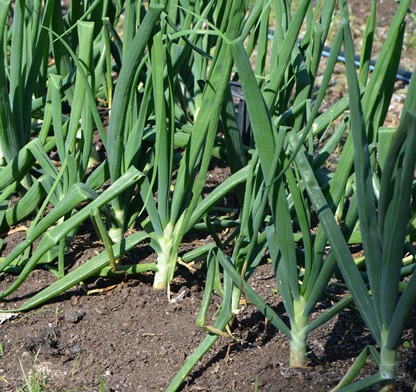
Onions are simple to grow and take up very little space. This is an easy selection for a beginning gardener.
The winter weather is finally giving way to springtime. While temperatures have been erratic, the rain has been sufficient.
There are still plenty of cool season leafy garden crops in production, but they will not last long as the temperatures rise.
One in-ground selection does offer some options. Onions planted last fall provide the greens and the bulb for a nutritional flavor enhancer from salads to a variety of dishes.
The common onion, Allium cepa, has many varieties within the species, and is grown and consumed worldwide. Garlic, chives and leeks are in the same genus as onions with their use similar to onions, but not nearly as frequent.
This popular and simple to grow fall vegetable easily handled the harshest north Florida winters. The multiple mornings of subfreezing temperatures and hard frost had no appreciable effect on this versatile vegetable.
Most regional soils can provide a good growing medium for onions. The lack of sulfur in the dirt and the excellent drainage are two requirements for producing a potentially mild bulb, depending on the cultivar planted.
The high levels of available phosphate in most soils also are an advantage when growing onions.
The Granex yellow onion cultivar is likely the current favorite among many gardeners. This is the same cultivar which produces some the premium branded mild onions on the market today.
Onions can be planted from August to March, either by seed or bulbs. Two inch spacing between plants provide enough space to grow and does not waste limited cultivation area.
Days to harvest depend on how the onion is to be used. Green onions, sometimes known as scallions, take four months with bulb onions taking five months or longer.In reality, onions are biennial but are usually grown as annuals.
Historical evidence of onion usage dates back 7,000 years to the Bronze Age. It is uncertain if these bulbs were cultivated or collected in the wild.
Their ease of transportation, long shelf life, and many uses made them an ideal candidate for long distance travel and trade in the days before refrigeration and high-speed movement of vegetables. Every culture and nation has its own special uses for onions.
Today’s onions provide the consumer with a combination of excellent nutrition, and good storage and handling qualities while enhancing the flavor of many meats, vegetables and salads. The bulbs come in three colors (red, yellow and white) which add to the visual quality of the dining experience.
Onions deliver vitamins B-6, C and Folic Acid. They are naturally low in sodium and fats, and contain four percent sugar.
Onions have compounds such as favonoids and phenolics which have had numerous positive health benefits attributed to them. Their consumption can be part of a healthy diet.
Properly handled onions have a potentially long storage life. Store in a cool, dry, well-ventilated area with 45 to 55 degrees the ideal temperature range.
To learn more about growing onions grown in north Florida, visit your UF/IFAS County Extension office or read the Florida Vegetable Gardening Guide.
- Get Your Trees Ready For The Winds of October - October 8, 2019
- Feeding Caterpillars Aren’t Always Cute - August 10, 2018
- Wild Azaleas - May 23, 2018
